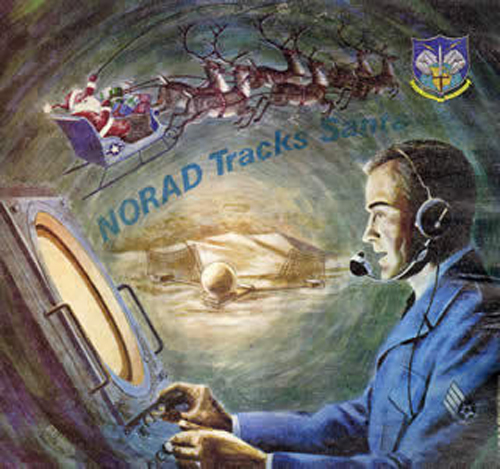How Does NORAD 'Track' Santa?

For more than 50 years, NORAD — the North American Aerospace Defense Command — has used its high-tech missile-tracking systems to track Santa's progress during his annual Christmas Eve flight around the world.
For a 24-hour period, about 1,200 military volunteers take shifts manning the command center at Peterson Air Force Base in Colorado; they monitor radar screens and field calls from excited 7-year-olds who ask for updates on Santa's location. They also update Kris Kringle's progress on the Google Earth map on the NORAD Tracks Santa website, as well as the Facebook page and the Twitter feed.
For the first time this year, people can even keep constant tabs on Santa's sleigh by downloading the NORAD Tracks Santa iPhone and Android apps. In other words, the program is a big deal, and it get bigger every Christmas.
But how do they do it? How does NORAD "track" Santa? [Is There a Santa Claus?]
When asked whether the volunteers plan the jolly old elf's route ahead of time, U.S. Navy Lieutenant Commander Bill Lewis, a Santa tracker, was having none of that.
"We don't plan it, he does," Lewis said. "We just monitor his travels with our ground-based radar, satellites, fighter aircraft, and, of course, the Santa Cams — he passes over certain cities, and based on the track we're projecting, we've got cameras set up."
Get the Space.com Newsletter
Breaking space news, the latest updates on rocket launches, skywatching events and more!
The NORAD team monitors a radar system called the North Warning System, which consists of 47 installations strung across the northern border of North America, for indications that Santa Claus has left the North Pole.
"Rudolph's nose puts off quite the heat signature," Lewis told Life's Little Mysteries.
The Christmas program isn't so out of the ordinary for the men and women of NORAD: "365 days a year we track possible threats to the homeland. So tracking Santa as an airborne object fits into our mission set," he said.
Through his experience as a Santa Tracker, Lewis was able to offer a bit of insight into an age-old question: How Santa manages to make it all the way around the world, sort through Can Tech Help Santa Deliver the Goods? 5 Tech Upgrades for Claus]
That's 671 million miles (1 billion kilometers) per hour, which means Santa can travel more than 16 billion miles (26 billion km) in the 24 hours allotted for his journey. A trip round the world is only 25,000 miles (40,000 kilometers), so at his estimated flight speed, Santa could technically circumnavigate Earth 650,000 times if he wanted.
He doesn't, of course — instead, he takes it slow and downs a mindblowing number of cookies and glasses of milk along the way.
Follow Natalie Wolchover on Twitter @nattyover. Follow Life's Little Mysteries on Twitter @llmysteries, then join us on Facebook.
Join our Space Forums to keep talking space on the latest missions, night sky and more! And if you have a news tip, correction or comment, let us know at: community@space.com.

Natalie Wolchover was a staff writer for Live Science and a contributor to Space.com from 2010 to 2012. She is now a senior writer and editor at Quanta Magazine, where she specializes in the physical sciences. Her writing has appeared in publications including Popular Science and Nature and has been included in The Best American Science and Nature Writing. She holds a bachelor's degree in physics from Tufts University and has studied physics at the University of California, Berkeley.










